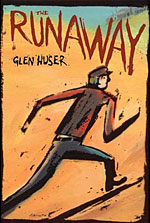The Runaway - Questions and Activities
 Books | About the Book | Synopsis | Questions & Activities
Books | About the Book | Synopsis | Questions & Activities
1. Leroy runs away because of the grueling working conditions and the lack of affection he experiences living with relatives. He also receives physical beatings at the hands of his cousins. Would it be possible for a teen to go through a similar experience today? For what other reasons do young people run away from home today?
2. In the beginning of the novel, Leroy, looking back, reflects on his life being pretty normal for a kid his age. Do you think things have changed much since the 1920s? In what ways would Leroy’s life be similar to a kid’s today? Different?
3. People flocked to the weeklong entertainments the Chautauqua offered in 1923. Are there similarities to what caught the attention of Chautauqua-goers then and what entertains people today? What are the differences?
4. Melodramatic plays were popular in the early days of the 20th century – and, at times, these were performed on the Chautauqua circuit. In some ways, the story of The Runaway deliberately borrows elements of melodrama. Identify these and comment on them.
5. If you were able to time-travel back to 1923 and connect up with a Chautauqua operation, how would you choose to be involved? In today’s world, how would you prefer to be involved in an entertainment presentation?
6. Apart from Leroy – which was your favorite character in the novel? Comment on what appealed to you about this character.
7. Comment on a part of the novel that made you laugh.
8. Were there any parts that touched you in a serious way? Comment on these.
9. Visualize the novel being made into a film. Who would you cast in the various roles?
Activities
1. Research to see what you can find out about the Chautauqua shows and how they got started. There is a good deal of information available on the Internet. Make notes, prepare and present your findings to your group or class.
2. Create a poster showing a typical Chautauqua tent. Add images of famous speakers and entertainers who were involved in the Chautauqua circuits. You might want to also include an archival photo or two (available on the Internet) showing people attending a Chautauqua show – or on the grounds outside the tent.
3. Music was an important part of the Chautauqua shows. Research two or three musical selections that would have been popular. Present these to your group or class. (Options: sing or play an instrument yourself; find a video version on the Internet and play that; obtain recordings from your local public library and choose the selections from them.)
4. Create a crayon drawing of someone willing to pose for you – using the techniques that Doodle uses. (Or…create a crayon sketch of a pet, as Doodle does when he visits the Widow Van Koopel.)
5. Choose a favorite part of the The Runaway and create a filmed trailer (advertisement) for the book.
6. Who were the famous movie stars of the silent-movie era? Was one of the actresses actually an opera-singer who never got to use her fabulous voice on film? (like Clementine Cavallero in the novel). Present an illustrated report (you might be able to include a film clip) on the movie star you find the most intriguing.
7. Imagine you are a costume designer or a set designer for a film version of The Runaway. Create one or two production designs to show the film’s director.
8. Are you a doodlebug? Replicate a sketch or two you can imagine Leroy having in his portfolio.
9. The Runaway is introduced (and wrapped up) in the voice of an old man telling about an important couple of years in his life. How does the author create the features of this voice? Think of a historical period or event you would like to explore and write the opening chapter, paying particular attention to the “voice” of the narrator.
10. With others, develop a skit of the part of the novel you liked the best.
